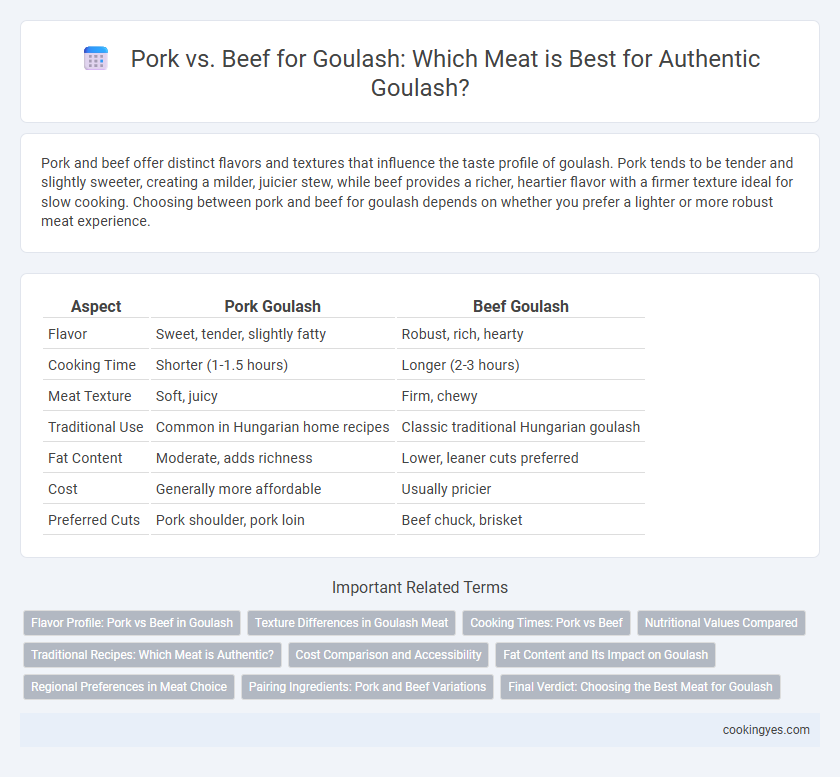Pork and beef offer distinct flavors and textures that influence the taste profile of goulash. Pork tends to be tender and slightly sweeter, creating a milder, juicier stew, while beef provides a richer, heartier flavor with a firmer texture ideal for slow cooking. Choosing between pork and beef for goulash depends on whether you prefer a lighter or more robust meat experience.
Table of Comparison
| Aspect | Pork Goulash | Beef Goulash |
|---|---|---|
| Flavor | Sweet, tender, slightly fatty | Robust, rich, hearty |
| Cooking Time | Shorter (1-1.5 hours) | Longer (2-3 hours) |
| Meat Texture | Soft, juicy | Firm, chewy |
| Traditional Use | Common in Hungarian home recipes | Classic traditional Hungarian goulash |
| Fat Content | Moderate, adds richness | Lower, leaner cuts preferred |
| Cost | Generally more affordable | Usually pricier |
| Preferred Cuts | Pork shoulder, pork loin | Beef chuck, brisket |
Flavor Profile: Pork vs Beef in Goulash
Pork goulash offers a sweeter and more tender flavor profile, with the fat content contributing to a rich, juicy texture that melds well with paprika and garlic. Beef goulash delivers a deeper, heartier taste, characterized by robust umami notes and a firmer texture that intensifies with slow cooking. Selecting pork or beef significantly influences the overall flavor complexity and mouthfeel of traditional Hungarian goulash dishes.
Texture Differences in Goulash Meat
Pork in goulash typically offers a tender, slightly fattier texture that becomes succulent when slow-cooked, enhancing the dish's richness and mouthfeel. Beef provides a firmer, more robust texture that holds its shape better during simmering, resulting in a heartier, chewier bite. Choosing pork or beef significantly influences the overall texture profile, with pork delivering softness and beef emphasizing structure within traditional goulash recipes.
Cooking Times: Pork vs Beef
Pork goulash typically requires shorter cooking times, around 1 to 1.5 hours, due to its tender texture and quicker heat penetration, making it ideal for faster meals. Beef goulash, especially when using tougher cuts like chuck or brisket, benefits from slow cooking for 2 to 3 hours or more to break down connective tissues and achieve a rich, tender consistency. Adjusting cooking times based on the type of meat ensures optimal flavor absorption and desired tenderness in traditional goulash recipes.
Nutritional Values Compared
Pork goulash typically contains higher fat content, providing more calories and saturated fats compared to beef, which is generally leaner and offers a higher protein-to-fat ratio. Beef goulash is richer in iron and vitamin B12, essential for red blood cell production and energy metabolism, while pork provides more thiamine (vitamin B1), crucial for carbohydrate metabolism. Choosing between pork or beef goulash depends on dietary goals, balancing protein intake with fat levels and specific micronutrient benefits.
Traditional Recipes: Which Meat is Authentic?
Traditional goulash recipes predominantly use beef, which provides a rich, hearty flavor and tender texture essential to authentic Hungarian dishes. Pork is occasionally used in regional variations but is less common in classic preparations that emphasize long, slow cooking for deep flavor development. The choice of beef, especially cuts like chuck or shin, aligns with historical authenticity and the robust taste profile cherished in genuine goulash.
Cost Comparison and Accessibility
Pork is generally more affordable and widely accessible than beef in goulash recipes, making it a cost-effective choice for home cooks and restaurants. Beef tends to have a higher price point due to its stronger demand and slower production cycle, which can impact overall meal cost. Accessibility varies by region, with pork more prevalent in Central and Eastern European markets, whereas beef may be favored in areas with established beef cattle industries.
Fat Content and Its Impact on Goulash
Pork contains a higher fat content than beef, which results in a richer and more flavorful goulash with a tender texture due to the rendered fat during cooking. Beef, especially lean cuts, offers a leaner option that produces a denser, meatier goulash but may require longer simmering to break down connective tissues and release flavors. The fat content in pork enhances the sauce's mouthfeel and helps balance the dish's paprika and spices, while beef's lower fat level results in a sharper, more robust taste profile.
Regional Preferences in Meat Choice
Regional preferences for goulash meat choices vary significantly, with beef being favored in Hungary and parts of Central Europe due to its rich flavor and traditional use in classic recipes. In contrast, pork is more commonly used in Slovakian and some Eastern European versions, offering a slightly sweeter taste and tender texture. These regional distinctions in meat selection contribute to the diverse and authentic goulash variations enjoyed across Europe.
Pairing Ingredients: Pork and Beef Variations
Pork goulash pairs exceptionally well with paprika, garlic, and smoky bacon, enhancing its rich and slightly sweet flavor profile. Beef goulash benefits from robust ingredients like caraway seeds, onions, and red wine, which deepen its hearty, savory character. Both variations complement root vegetables and potatoes, but pork's lighter texture balances well with tangy sour cream, while beef thrives with bold, earthy spices.
Final Verdict: Choosing the Best Meat for Goulash
Beef remains the classic choice for goulash, offering a rich, robust flavor and tender texture when slow-cooked, ideal for absorbing the traditional paprika and spices. Pork provides a slightly sweeter and milder taste, becoming juicy and tender, making it a suitable alternative for those preferring a lighter profile. Ultimately, selecting beef or pork depends on desired flavor intensity and texture, but beef is generally favored for authentic, hearty goulash dishes.
Pork vs Beef for Goulash Infographic

 cookingyes.com
cookingyes.com